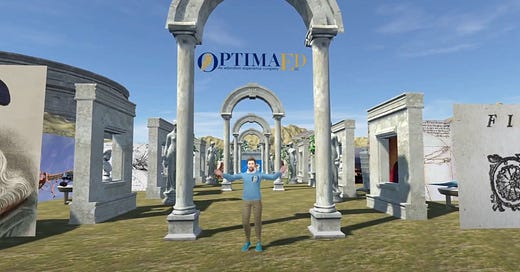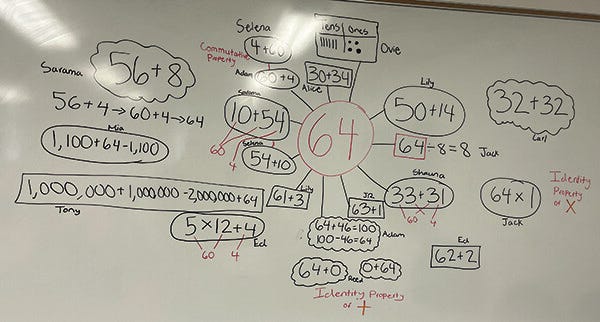All the Math EdTech News That’s Fit for Me to Read
Several articles about generative AI, two math tasks, and a field trip to Mt. Everest that turns into a teacher's nightmare, though not for the reason you'd imagine.
Hi there! I have had a week—three presentations, including one on the opportunities and limitations of generative AI for the Association of State Supervisors of Mathematics, and 3,000 words for a grant proposal. There are a couple of topics I’d like to think and write about with you but given the demands of the week I am trying a new kind of newsletter where I just share the most interesting ideas I read this week along with a quick bit of analysis.
First, upcoming presentations.
Come hang out and chat in person / webinar with me at these upcoming events:
September 26 - IES Math Summit - online
October 19 - Montana FPE Educator Conference - Billings, MT
October 25 - NCTM Annual Conference - Washington, DC
October 27 - GRMS Annual Conference - Victoriaville, QC
November 3 - CMC South - Palm Springs, CA
December 1 - CMC North - Pacific Grove, CA
A great webinar on generative AI and its discourse.
The Generative AI Mirror: The Five Pathologies of EdTech Discourse About New Technologies. Great title. Great speakers in Glenda Morgan and Phil Hill. Check out the recording or slides. Morgan’s bullet that “learning as the only approach to change” hit me right in the gut. Maybe the biggest generative AI transformation will be in the front office rather than the classroom?
The metaverse is back.
There are no fewer than three interesting angles in this feature on a small network of schools called Optima Academy - (1) school choice (2) classical education (3) virtual reality in the metaverse. Virtual charter schools have a terrible track record and I’ll be surprised if it’s reversed by virtual reality or the metaverse. If you want a look at the challenges of facilitating a class activity in VR, you really have to scroll down to the anecdote headed off by “a field trip to an Everest base camp.”
But there was also a physical rule put in place: no one could move the controller in their left hand. Otherwise, they’d fall from the mountain and force the whole group back to base camp, where we’d have to start all over again.
You will never guess what happened when you give every student in the class access to a point of failure for the entire lesson, unless you are a classroom teacher in which case you will definitely guess what happened.
Reach Capital: Generative AI hasn’t changed the fundamentals.
Reach Capital (disclosure: current investor in Amplify) has analyzed 280+ generative AI tools that have either pitched them for capital or crossed their research desk.
Effective pedagogy reigns supreme. We’ve long believed that the best edtech tools are those informed by educational research, and AI that enables and scales proven pedagogical practices are the most impactful. There is a lot of hope for AI tutors, and they may well be capable of handling content and instructional delivery. But how well can they motivate, inspire and understand the complexity of young, developing minds?
Let Natasha Singer know if you’re using generative AI in your classroom.
Natasha Singer’s reporting on classroom use of AI has been invaluable over the last 12 months. (I commented on her reporting from Newark Public Schools a few months ago.) This last week she asked teachers to invite her into their classes if they’re using AI tools.
Clever has an interesting survey of the “Classroom of the Future.”
The slides on generative AI (slides 10-15 of the report) are somewhat hard to parse for me. On the one hand, 89% of teachers believe generative AI will have a moderate or significant impact on teaching (slide 14). On the other hand, excitement about that impact seems pretty muted (slide 15 pictured above). I suppose Clever didn’t ask teachers if they thought that impact would be positive ... ?
EdTech market analysts are feeling a bit saturated with the promises of generative AI.
Matthew Tower, one of the most lucid edtech market analysts I follow, wrote a new guiding principle for his analysis at his newsletter (paywalled) this week:
I am now proactively avoiding using the word “AI” when describing companies. Too many companies use it as filler and/or to please investors/press. If the company or feature is still interesting when described without “AI”, my confidence in its potential goes up dramatically.
via
/Here is a teacher making a deposit of social capital into a student’s account.
Check out the result of Ben Herrman transferring a huge stack of social currency into the account of a student who hasn’t received much of it historically. In this current moment, this facet of the work of teaching needs more attention.
Nick Corley reminds me of one of my favorite math tasks.
A tweet from Nick Corley this week reminded me of a task relayed to me by Malcolm Swan on a bus ride in Nottingham, rendered here by the Play With Your Math team.
This is a task that stretches from little to big kids and beyond.
Single Number Talks
NCTM’s teacher journal has a great (paywalled) article this week about “Single Number Talks,” the sort of math task that describes itself pretty effectively in its title alone.
When preparing for a Single-Number Number Talk, considering the current mathematics learning is important. For example, if the class is nudging toward developing an understanding of doubles, a choice of 16 or 18 might be a great selection. In an upper-elementary classroom, a teacher might choose to use 1/2 or .6 to complement a fractions or decimals unit.









Thanks for the shout out Dan! ChatGPT is getting really good at coming up with hot takes for my newsletter!
Thank you for choosing substance over style - including the paywall and amplify investors information in the text helps exhausted readers/teachers like me feel like I can trust your analysis. I wish more writers were as committed to transparency. Consistently excellent content.